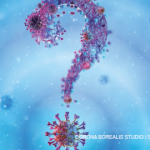A minority of patients experience lingering symptoms after infection with SARS-CoV-2, similar to some other previously known post-infection syndromes. Although we are just beginning to understand the different presentations, pathophysiology, risk factors, prognosis and treatment of long COVID, rheumatologists can play a leadership role in managing patients with the illness and contributing to this important research area.
Definitions
Efforts to study long COVID are made challenging by the fact that the syndrome is not yet well defined, and multiple terms have been used for post-COVID symptoms. The Centers for Disease Control and Prevention (CDC) defines postacute sequlae of COVID-19 (PASC) as persistent symptoms at least 28 days post infection with SARS-CoV-2, but the World Health Organization defines it more stringently, as persistent symptoms at least 90 days after infection.1-3
Distinguishing sequelae of COVID-19 from clear pathophysiological causes related to viral damage (e.g., symptoms from lung scarring) from those with symptoms of less clear origin is also important. Cassandra Calabrese, DO, a rheumatologist and infectious disease specialist who is an associate professor at the Cleveland Clinic Lerner College of Medicine, has defined long COVID as a syndrome with a variety of potential post-COVID symptoms that cannot always be explained by clear pathophysiology or an alternative diagnosis.4,5
Researchers have documented dozens of potential symptoms of long COVID, but the most common are:
• Post-exertional fatigue;
• Neurocognitive dysfunction (i.e., brain fog);
• Breathlessness; and
• Musculoskeletal pain.
In some patients, symptoms persist after the acute illness has ended. Others experience new-onset symptoms after the virus initially appears to have cleared.
Dr. Calabrese explains that patients seem to present with different clinical endotypes. For example, some have primarily a chronic fatigue similar to that of myalgic encephalomyelitis/chronic fatigue syndrome; others have predominant neurocognitive impairment; others display a pain endotype that resembles fibromyalgia; and some display more autonomic dysfunction, such as postural orthostatic tachycardia syndrome.
Pathophysiology
The pathophysiology of long COVID is unknown. Ongoing viral activation is a leading theory, and some emerging data support this idea of antigen and viral persistence.6 Some research has also demonstrated activation of both the innate and adaptive immune response, as well as the formation of various autoantibodies, although the relationship between such findings and symptoms is far from clear.7
Following acute infection with Epstein-Barr virus, SARS, West Nile virus, polio and dengue, a minority of patients experience chronic disability. Less clear evidence exists for chronic disability following varicella-zoster infection and post-treatment Lyme disease.8 But our understanding of the etiology of these post-infection syndromes is relatively poor. They are heterogeneous, and considerable overlap exists among common symptoms, such as fatigue, poor sleep, dysautonomia, musculoskeletal pain and neurocognitive complaints.
Further research on long COVID may reveal overlapping etiologies and markers to improve treatment for this broader class of disorders.8
Risk Factors & Incidence
Like other post-acute infection syndromes, long COVID appears to be more common in women. Jeffrey Sparks, MD, MMSc, an assistant professor of medicine at Harvard Medicine School, Boston, and a rheumatologist at Brigham and Women’s Hospital, Boston, explains that the most well-established risk factor is probably increased severity of COVID-19 infection. However, long COVID also occurs in some patients who had a mild disease course.
With Zachary Wallace, MD, MSc, an assistant professor of medicine at Harvard Medical School and a rheumatologist at Massachusetts General Hospital, Dr. Sparks is leading several National Institutes of Health-funded prospective studies of post-COVID symptoms in patients with rheumatic diseases. One such study demonstrated that vaccinated patients with systemic autoimmune rheumatic disease had lower rates of PASC.3
Some data also indicate that long COVID may be less frequent following infection with omicron variants than earlier variants.9 A preprint study reveals that long COVID may be less common in patients treated with nirmatrelvir in combination with ritonavir (Paxlovid).10
We don’t currently know how having an immune-mediated rheumatic disease may impact the presentation of long COVID or its overall risk. “That’s one of the research agenda items that we will be looking at,” says Dr. Calabrese.
Partly because of these differing definitions and changing variables of the pandemic itself, we don’t have good estimates of the incidence of long COVID or of PASC more broadly, but some estimates put it in the 15%-30% range.4 A study from the COVID-19 Global Rheumatology Alliance found that almost 10% of patients with systemic autoimmune rheumatic diseases reported persistent symptoms 90 days after infection.11
“Fortunately, dying from COVID is really uncommon these days,” says Dr. Sparks. “But as the mortality rate goes down, the importance of PASC rises, because there are a lot more survivors.”
Diagnosis, Treatment & Prognosis
Because no known biomarker for long COVID exists, diagnosis is clinical. Not all new-onset illness after a SARS-CoV-2 infection or a presumed SARS-CoV-2 infection is long COVID, but physicians can make a reasonable presumptive diagnosis after carefully excluding other potential causes of symptoms.
“It is really challenging to figure out what to do for long COVID patients because we don’t have a good understanding of how this phenotype mechanistically occurs,” says Alfred H. Kim, MD, PhD, assistant professor in the Division of Rheumatology at Washington University School of Medicine in St. Louis.
Dr. Calabrese notes that her clinic takes an integrative approach with patients, addressing medical comorbidities of long COVID when appropriate, as well as sleep issues, depression and autonomic dysfunction, if present. They also advise pacing strategies in patients with chronic fatigue, finding that over-exertion is often counterproductive for patients in the long term.
Health practitioners have experimented with many different therapies for such patients, although many in the absence of data. Prospective studies are currently underway for many different types of agents, including anti-virals, glucocorticoids, immunomodulating agents, such as infliximab, intravenous immunoglobulin (IVIG), hyperbaric oxygen and dietary supplements.4 It remains to be seen whether any of these treatments can be used to successfully treat patients with long COVID or specific long-COVID endotypes.
Even without intervention, many patients with long COVID appear to improve over time, and only a small percentage appear to be profoundly affected two to three years later.4 Dr. Sparks notes that post-COVID symptoms eventually resolve in the majority of rheumatology patients, even in those who still had symptoms 90 days after infection.
Rheumatologists’ Role
The public health implications of long COVID are substantial. “It’s easy to want to just go back to the status quo,” says Dr. Sparks, “but I think you have to recognize that this is probably a growing problem. It is a call to action to try to understand how to better treat these patients.”
Dr. Calabrese notes that rheumatologists are well versed in dealing with patients with long-term pain and fatigue.
“Until we have better understanding of long COVID that can drive more specific therapeutic decisions, empathy is going to be the most important medicine we can deliver patients right now,” says Dr. Kim. “The worst thing that a provider can do for any chronic condition is to discount those experiences.”
Ruth Jessen Hickman, MD, is a graduate of the Indiana University School of Medicine. She is a freelance medical and science writer living in Bloomington, Ind.
References
- Post-COVID conditions: Information for healthcare providers. Centers for Disease Control and Prevention. Updated 2022 Dec 16. https://www.cdc.gov/coronavirus/2019-ncov/hcp/clinical-care/post-covid-conditions.html.
- Soriano JB, Murthy S, Marshall JC, et al. A clinical case definition of post-COVID-19 condition by a Delphi consensus. Lancet Infect Dis. 2022 Apr;22(4):e102–e107.
- Patel NJ, Cook C, Vanni K, et al. Impact of vaccination on postacute sequelae of SARS CoV-2 infection in patients with rheumatic diseases [published online ahead of print, 2022 Nov 28]. Ann Rheum Dis. 2022 Nov28;ard-2022-223439.
- Calabrese C, Kirchner E, Calabrese LH. Long COVID and rheumatology: Clinical, diagnostic, and therapeutic implications. Best Pract Res Clin Rheumatol. 2022 Nov 8;101794.
- Calabrese LH, Calabrese CM. Long COVID: Defining the role of rheumatology in care and research. Lancet Rheumatol. 2022 Dec;4(12):e812–e814.
- Su Y, Yuan D, Chen DG, et al. Multiple early factors anticipate post-acute COVID-19 sequelae. Cell. 2022 Mar 3;185(5):881–895.e20.
- Knight JS, Caricchio R, Casanova JL, et al. The intersection of COVID-19 and autoimmunity. J Clin Invest. 2021 Dec 15;131(24):e154886.
- Choutka J, Jansari V, Hornig M, et al. Unexplained post-acute infection syndromes. Nat Med. 2022 May;28(5):911–923.
- Antonelli M, Pujol JC, Spector TD, et al. Risk of long COVID associated with delta versus omicron variants of SARS-CoV-2. Lancet. 2022 Jun 18;399(10343):2263–2264.
- Xie Y, Choi T, Al-Aly Z. Nirmatrelvir and the risk of post-acute sequelae of COVID-19. medRvix preprint. 2022 Nov 3. https://www.medrxiv.org/content/10.1101/2022.11.03.22281783v1
- DiIorio M, Kennedy K, Liew JW, et al. Prolonged COVID-19 symptom duration in people with systemic autoimmune rheumatic diseases: Results from the COVID-19 Global Rheumatology Alliance vaccine survey. RMD Open. 2022 Sep;8(2):e002587.





